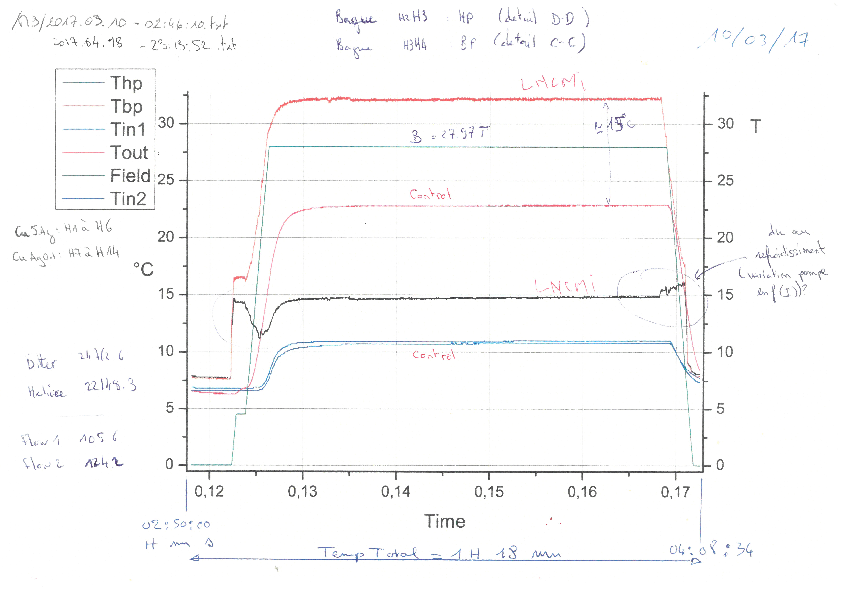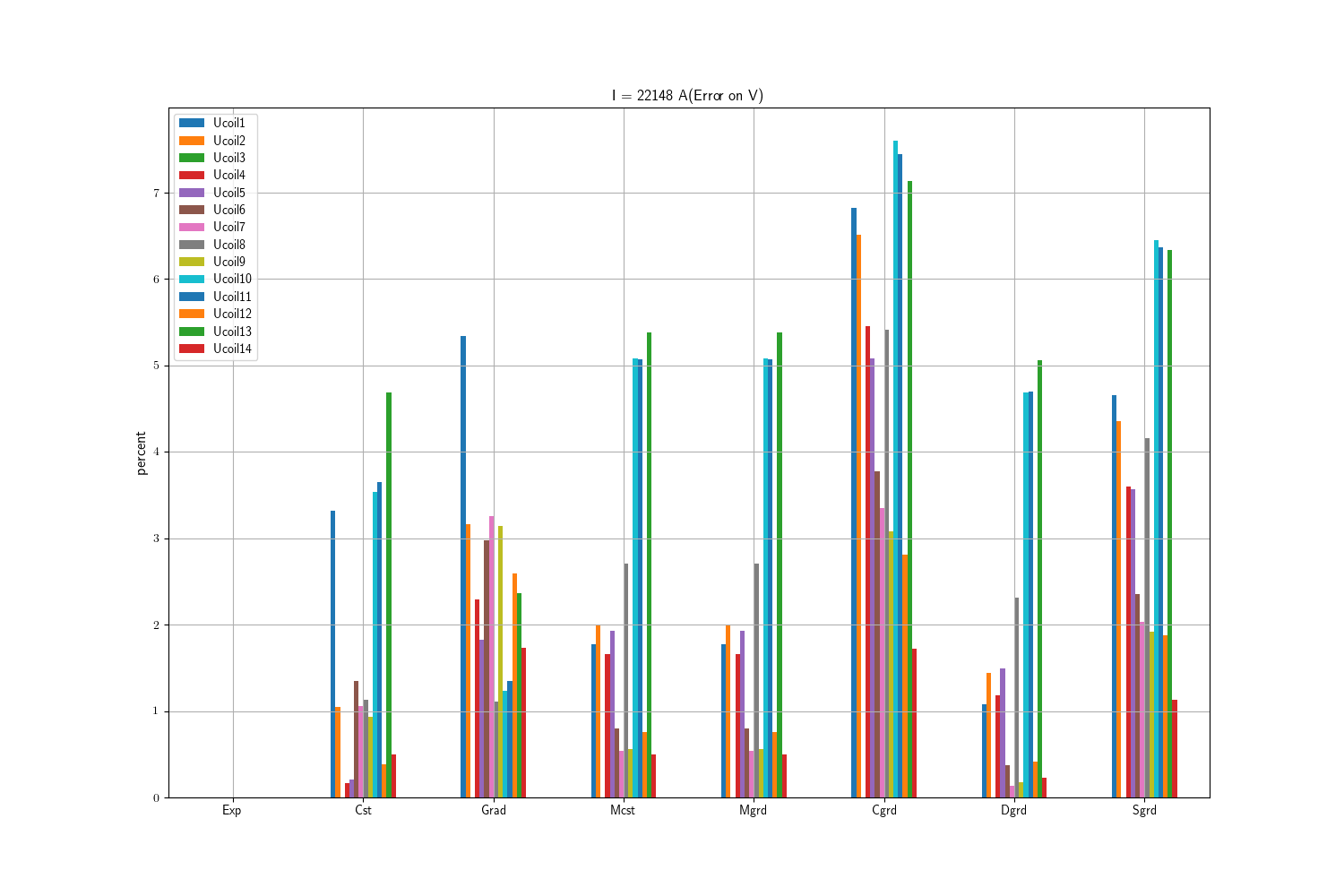Simulation of a Plateau
1. Introduction

In this example we will try to reproduce the behaviour of an 14 Helices insert operated on March 2017 during a Plateau . More precisely, we will compare:
-
the voltage tap measurements on HP and BP sides (ie on tap per helix)
-
the temperature measurement in the rings H2H3 and H3H4.
Beside the HiFiMagnet Salome plugins, the python scripts mentioned in the text may be found here.
2. Input data
| Helix | \(\sigma\) [\(M\Omega/m\)] | Nuance |
|---|---|---|
1 |
52.4 |
Cu5Ag Cold Spray |
2 |
53.3 |
" |
3 |
52.6 |
" |
4 |
52.8 |
" |
5 |
53.1 |
" |
6 |
53 |
" |
7 |
55.6 |
Cu0.1Ag Cold Spray |
8 |
55.6 |
" |
9 |
56.1 |
" |
10 |
55 |
" |
11 |
55 |
" |
12 |
55.5 |
" |
13 |
55.1 |
" |
14 |
55.4 |
" |
| Icoil1 [A] | Tin1 [C] | Tout [C] | HP1 [bar] | BP [bar] | Flow1 [\(l/s\)] | Notes |
|---|---|---|---|---|---|---|
22148.2 |
11.0 |
22.9 |
14.3 |
4.0 |
105.3 |
use
|
Model |
Notes |
Montgomery |
see excelsheet |
Others (Colburn,…) |
run |
For computed heat exchange coefficients, we will select the dataset that gives an estimate flow rate which is the closest to the measured one:
-
Design value with a constant friction coefficient,
-
Montgomery with a constant friction coefficient,
-
Colburn with a constant friction coefficient,
-
Dittus with a constant friction coefficient,
-
Silberberg with a constant friction coefficient.
A template thermoelectric model file may be create with:
salome -w1 -t $HIFIMAGNET/HIFIMAGNET_Cmd.py \
args:--cfg=HL-31.yaml,--setup,--cooling="MeanPressure/DPressure/MeanTemperature",--correlation=colburn,--friction="constant"with cooling="9.15/10.3/17.4875205"
3. Simulations
Sim |
Correlation |
Tw |
cfg |
Cst |
cst |
Tin1 |
HL-31_DeMarinis-cst.cfg |
Grad |
cst |
Tw=Tin1+DT1*z |
HL-31_DeMarinis.cfg |
Mcst |
Montgomery |
Tin1 |
HL-31_DeMarinis-montgomery-cst.cfg |
Mgrd |
"" |
Tw=Tin1+DT1*z |
HL-31_DeMarinis-montgomery-grad.cfg |
Cgrd |
Colburn |
Tw=Tin1+DT1*z |
HL-31_DeMarinis-colburn-grad.cfg |
Dgrd |
Dittus |
Tw=Tin1+DT1*z |
HL-31_DeMarinis-dittus-grad.cfg |
Sgrd |
Silberberg |
Tw=Tin1+DT1*z |
HL-31_DeMarinis-silberberg-grad.cfg |
4. Voltage taps
To get the computed voltage taps, we can use:
ensight102 [-X] -batch -p probe_voltage.py -pyargv -i Electrics.case -o out.data -b -endpyargv
python test.py --input_file out.data --exp_file ~/MSO4SC/hifimagnet-msoapps/Examples/HL-31-v105/M9_2017.03.10-02_46_10.txt --bpTo get the measured values:
python txt2csv.py --input_file M9_2017.03.10-02_46_10.txt --output_time "03:52:51" --output_key="Ucoil1;...;Ucoil14"U1 |
U2 |
U3 |
U4 |
U5 |
U6 |
U7 |
U8 |
U9 |
U10 |
U11 |
U12 |
U13 |
U14 |
|
Exp |
6.7 |
8.1 |
NA |
22.6 |
13.2 |
16.0 |
17.7 |
20.3 |
22.9 |
25.1 |
27.1 |
28.6 |
26.1 |
24.2 |
Cst |
6.48 |
8.02 |
9.99 |
12.57 |
13.17 |
15.79 |
17.51 |
20.53 |
22.69 |
25.99 |
28.09 |
28.49 |
27.32 |
24.32 |
Grad |
6.34 |
7.84 |
9.78 |
12.30 |
12.96 |
15.52 |
17.12 |
20.07 |
22.18 |
25.41 |
27.47 |
27.86 |
26.72 |
23.78 |
Mcst |
6.82 |
8.26 |
10.17 |
12.81 |
13.45 |
16.13 |
17.79 |
20.85 |
23.03 |
26.37 |
28.47 |
28.82 |
27.50 |
24.32 |
Mgrd |
6.82 |
8.26 |
10.17 |
12.81 |
13.45 |
16.13 |
17.79 |
20.85 |
23.03 |
26.37 |
28.47 |
28.82 |
27.50 |
24.32 |
Cgrd |
7.16 |
8.63 |
10.56 |
13.28 |
13.87 |
16.60 |
18.29 |
21.40 |
23.60 |
27.01 |
29.11 |
29.40 |
27.96 |
24.62 |
Dgrd |
6.77 |
8.22 |
10.12 |
12.75 |
13.40 |
16.06 |
17.72 |
20.77 |
22.94 |
26.28 |
28.37 |
28.72 |
27.42 |
24.25 |
Sgrd |
7.01 |
8.45 |
10.36 |
13.05 |
13.67 |
16.38 |
18.06 |
21.14 |
23.34 |
26.72 |
28.82 |
29.14 |
27.75 |
24.47 |
|
|

5. Temperature probes
To get the computed voltage taps, we can use:
ensight102 [-X] -batch -p probe_temp.py -pyargv -i Thermics.case -o out.data -b -endpyargvObviously, we will only consider simulations where Tw is defined as a gradient
for each cooling channel:
HP [K] |
BP [K] |
|
Exp |
287.95 |
305.35 |
Grad |
286.967 |
294.296 |
Mgrd |
287.052 |
294.356 |
Cgrd |
287.145 |
294.413 |
Dgrd |
287.139 |
294.351 |
Sgrd |
287.101 |
294.386 |
6. Helices Mean Temperature
To compute the mean temperature per helix:
ensight102 -X -batch -p $HOME/MSO4SC/hifimagnet-msoapps/Examples/HL-31-v105/view.py -pyargv -i Thermics.case -f T -endpyargvThe result will be stored in T_vMean.dat.
To get the "measured" values in Celsius:
python txt2csv.py --input_file M9_2017.03.10-02_46_10.txt --output_time "03:52:51" --output_key="Tcal1;...;Tcal14"T1 |
T2 |
T3 |
T4 |
T5 |
T6 |
T7 |
T8 |
T9 |
T10 |
T11 |
T12 |
T13 |
T14 |
|
Exp |
70.3 |
73.2 |
NA |
74.1 |
65.5 |
61.3 |
63.2 |
61.2 |
59.6 |
57.5 |
55.6 |
58.9 |
46.2 |
39.2 |
Cst |
46.87 |
60.77 |
58.78 |
57.87 |
52.32 |
51.79 |
49.14 |
48.59 |
47.18 |
46.93 |
45.52 |
42.94 |
39.59 |
35.61 |
Grad |
38.72 |
54.01 |
52.31 |
51.17 |
45.98 |
45.22 |
42.83 |
42.06 |
40.84 |
40.43 |
39.21 |
36.54 |
33.43 |
29.48 |
Mcst |
52.00 |
66.71 |
61.46 |
61.15 |
54.60 |
54.34 |
51.28 |
50.77 |
49.03 |
48.81 |
47.03 |
43.69 |
39.35 |
34.17 |
Mgrd |
49.78 |
66.25 |
61.26 |
60.69 |
54.40 |
53.90 |
51.08 |
50.33 |
48.76 |
48.37 |
46.76 |
43.26 |
39.10 |
33.75 |
Cgrd |
58.30 |
77.70 |
71.00 |
70.19 |
62.14 |
61.38 |
57.79 |
56.76 |
54.72 |
54.18 |
52.10 |
47.89 |
42.87 |
36.59 |
Dgrd |
49.07 |
65.28 |
60.43 |
59.88 |
53.73 |
53.26 |
50.50 |
49.77 |
48.24 |
47.87 |
46.29 |
42.86 |
38.77 |
33.50 |
Sgrd |
54.82 |
72.41 |
66.36 |
65.75 |
58.59 |
58.00 |
54.80 |
53.94 |
52.13 |
51.68 |
49.83 |
45.94 |
41.30 |
35.36 |